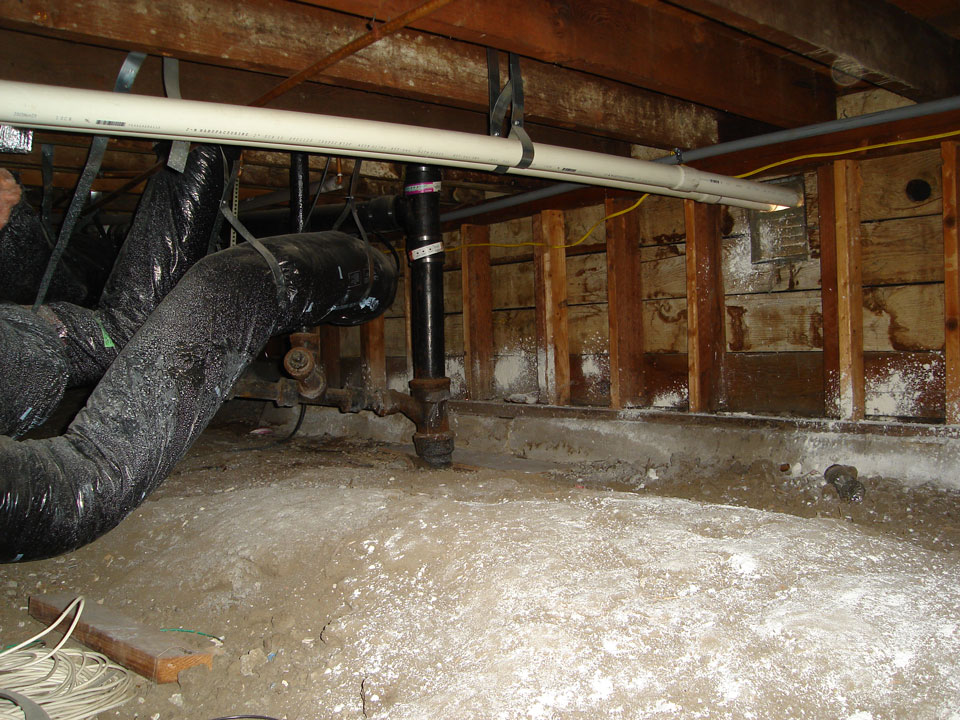How To Deal With Water In Your Crawl Space

Water in your crawl space is a pain to get rid of, but you shouldn’t sit on it, even if it’s only a tiny bit of moisture. While finding crawl space solutions might seem like a lot of work, the problems will only get worse if any amount of water is allowed to fester. Soggy insulation and mold are just the beginning – infestations, weak foundation walls, and more await a drainage issue that isn’t resolved quickly. Here’s how you can get rid of that water and make sure it stays out!
 What’s Causing The Water In My Crawl Space?
What’s Causing The Water In My Crawl Space?
The first thing to do when you see water in the crawl space is assess the situation. Examine your lower levels and try and locate the source of the water: is it coming from the ground, the walls, or inside? If it’s pooling from the inside, then you need to call a plumber or tackle that leaky pipe yourself. If it’s coming through the floor or walls, you need to call a drainage expert.
Water often makes its way into your crawl space by seeping in through cracks in brick and concrete, but obvious weak points aren’t always the culprit. Concrete and grout are porous materials that absorb moisture, giving it easy access to your basement or crawl space. It can be deceiving, too, so while the walls on the outside look dry, inside water is passing through, creating a moist environment and even flooding.
Water coming up through the floor is another big issue for crawl spaces, especially since many of them are not finished in homes. After the basement or crawl space is dug out and the walls are built, there’s a gap around the outer edges. This is usually filled in with loose soil, which can’t be as compact as the undisturbed earth around it; this looser soil absorbs more water, a tendency called the “clay bowl effect”. As the hydrostatic pressure builds, the excess water looks for a path of least resistance in which to travel, and this is how it gets into unfinished basements or dirt floor crawl spaces. If it’s unfinished, you’ll end up with a lot of messy mud that can make cleanups much more difficult.
 Install a Sump Pump or Upgrade Your Drainage
Install a Sump Pump or Upgrade Your Drainage
The best solutions to wet crawl spaces are sump pumps and effective drainage systems. If you have a crawl space, it’s usually the lowest part of your home, and due to gravity, here is where any leaks will drain. This is the best spot to have a sump pump or exit drain that removes the water that could pool up from excess moisture and discharges it away from your foundation.
If you already have a system or sump pump in place, make sure that it’s working properly and effectively. Test it out and make sure that all the components, from the activating float to the engine, are working properly.
Other ways to tackle a wet crawl space include having this little nook finished and covered with a moisture barrier; create more ventilation so that moisture is left to stand in a dank, dark space; and using electric fans or dehumidifiers to reduce moisture. Sometimes, though, the amount of moisture might hint at a bigger problem with your foundation, and you need more intensive work to get rid of it.
 Keeping Moisture Away: Round Stone Treatment
Keeping Moisture Away: Round Stone Treatment
The best way to keep the moisture out of your crawl space is to ensure that no moisture gets close to your walls and floor in the first place. The barrier provided by the loose round stones, which let moisture fall between them to a weeping tile system at the foot of the foundation, creates an effective drainage system that eliminates the biological and structural hazards that moisture can create.
Because of how it’s built, the crawl space might draw more water than you’d like. Just know that there are many treatments that can keep it moisture-free and prevent other, bigger problems at the foundation. Don’t sit on it and try to forget it exists – work on your crawl space solutions now! And don’t forget to read more about home drainage and waterproofing here.
